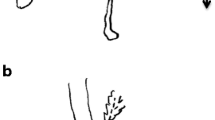Abstract
The behavior of 118 spruce bark beetles, Ips typographus,was observed on trees under colonization. Most individuals were followed from when they landed until they entered or left the tree. Both males and females spent most time inspecting crevices and searching for a place to start boring or for a hole to enter. These behaviors accounted for 87 and 70% of all behavioral acts recorded for males and females, respectively. Females entered galleries with males only after a period of pushing at the gallery entrance. Males spent on average 3 min and females 4 min on the bark before entering or leaving the tree. Thirty-three percent of the beetles eventually entered the tree, 31% flew away, 35% dropped from the host, and one beetle was eaten by a predator. The results are discussed in relation to the question of mate choice in bark beetles and to studies on attack dynamics of spruce bark beetle populations.
Similar content being viewed by others
References
Anderbrant, O., Schlyter, F., and Birgersson, G. (1985). Intraspecific competition affecting parents and offspring in the bark beetleIps typographus.Oikos 45: 89–98.
Anderbrant, O., Schlyter, F., and Löfqvist, J. (1988). Dynamics of tree attack in the bark beetleIps typographus under semi-epidemic conditions. In Payne, T. L., and Saarenmaa, H. (eds.),Integrated Control of Scolytid Bark Beetles, Proceedings, IUFRO/XVIII International Congress of Entomology Symposium, College of Agriculture and Life Sciences, VPI & SU, Blacksburg, Va, pp. 35–52.
Birgersson, G., Schlyter, F., Löfqvist, J., and Bergström, G. (1984). Quantitative variation of pheromone components in the spruce bark beetle,Ips typographus from different attack phases.J. Chem. Ecol. 10: 1029–1055.
Borden, J. H. (1967). Factors influencing the response ofIps confusus (Coleoptera: Scolytidae) to male attractants.Can. Entomol. 99: 1164–1193.
Borden, J. H. (1977). Behavioural responses of Coleoptera to pheromones, allomones and kairomones. In Shorey, H. H., and McKelvey, J. J. (eds.),Chemical Control of Insect Behaviour, Theory and Applications, John Wiley and Sons, New York, pp. 169–198.
Bunt, W. D., Coster, J. E., and Johnson, P. C. (1980). Behaviour of the southern pine beetle on the bark of host trees during mass attack.Ann. Entomol. Soc. Am. 73: 647–652.
Byers, J. A. (1983). Sex-specific response to aggregation pheromone: Regulation of colonization density in the bark beetle,Ips paraconfusus.J. Chem. Ecol. 9: 129–142.
Byers, J. A. (1984). Nearest neighbour analysis and simulation of distribution patterns indicates an attack spacing mechanism in the bark beetle,Ips typographus (Coleoptera: Scolytidae).Environ. Entomol. 9: 1191–1200.
Byers, J. A., and Löfqvist, J. (1989). Flight initiation and survival in the bark beetle,Ips typographus during spring dispersal.Holarct. Ecol. 12: 432–440.
Byers, J. A., Anderbrant, O., and Löfqvist, J. (1989). Effective attraction radius: A method for comparing species attractants and determining densities of flying insects.J. Chem. Ecol. 15: 749–765.
Coulson, R. N. (1979). Population dynamics of bark beetles.Annu. Rev. Entomol. 24: 417–447.
De Jong, M. C. M., and Sabelis, M. W. (1988). How bark beetles avoid interference with squatters: An ESS for colonization byIps typographus. Oikos51: 88–96.
Gara, R. L., and Coster, J. E. (1968). Studies on the attack behaviour of the southern pine beetle 3. Sequence of tree infestation within stands. Contrib. Boyce Thompson Inst.24: 69–79.
Geiszler, D. R., and Gara, R. I. (1978). Mountain pine beetle attack dynamics in lodgepole pine. In Baumgartner, D. M. (ed.),Theory and Practice of Mountain Pine Beetle Management in Lodgepole Pine Forests, Wash. State Univ. Coop. Ext Serv., Pullman, pp. 182–187.
Goodman, L. A. (1968). The analysis of cross-classified data: independence, quasi-independence, and interactions in contingency tables with or without missing entries.J. Am. Stat. Assoc. 63: 1091–1131.
Harding, S., and Ravn, H. (1983). Undersøgelse afIps typographus (L.)′, biologi og øfkologi i Danmark, M.S. thesis, Department of Population Biology, University of Copenhagen, Copenhagen.
Leonard, S. H., and Ringo, J. M. (1978). Analysis of male courtship patterns and mating behaviour ofBrachymeria intermedia.Ann. Entomol. Soc. Am. 71: 817–826.
Nie, N. H., Hull, C. H., Jenkins, K., Steinbrenner, K., and Bent, D. H. (1975).Statistical Package of the Social Sciences, McGraw-Hill, New York.
Paterson, H. E. H. (1985). The recognition concept of species. In Vrba, E. S. (ed.),Species and Speciation, Transvaal Museum, Pretoria, pp. 21–29.
Pope, D. N., Coulson, R. N. Fargo, W. S., Gagne, J. A., and Kelley, C. W. (1980). The allocation process and between-tree survival probabilities inDendroctonus frontalis infestations.Res. Popul. Ecol. 22: 197–210.
Rudinsky, J. A. (1979). Chemoacoustically induced behaviour ofIps typographus (Col.; Scolytidae).Z. ang. Ent. 88: 537–541.
Schlyter, F. (1985).Aggregation Pheromone System in the Spruce Bark Beetle Ips typographus, Ph.D. dissertation, University of Lund, Lund.
Schlyter, F., and Anderbrant, O. (1989). Mass-attack of trees byIps typographus induced by sex-specific pheromone. A model of attack dynamics.Holarct. Ecol. 12: 415–426.
Schlyter, F., and Cederholm, I. (1981). Separation of the sexes of living spruce bark beetles,Ips typographus (L.) (Coleoptera: Scolytidae).Z. ang. Ent. 92: 42–47.
Schlyter, F., and Löfqvist, J. (1986). Response of walking spruce bark beetlesIps typographus (L.) to natural pheromone from different attack phases.Entomol. Exp. Appl. 41: 219–230.
Schlyter, F., Löfqvist, J., and Byers, J. (1987a). Behavioural sequence in the attraction of the bark beetleIps typographus to pheromone sources.Physiol. Entomol. 12: 185–196.
Schlyter, F., Byers, J., and Löfqvist, J. (1987b). Attraction to pheromone sources of different quantity, quality and spacing: Density-regulation mechanisms in the bark beetleIps typographus. J. Chem. Ecol.13: 1503–1523.
Slater, P. J. B. (1973). Describing sequences of behavior. In Bateson, P. P. G., and Klopfer, P. H. (eds.),Perspective in Ethology, Plenum Press, New York, Chap. 5.
Author information
Authors and Affiliations
Rights and permissions
About this article
Cite this article
Paynter, Q.E., Anderbrant, O. & Schlyter, F. Behavior of male and female spruce bark beetles,Ips typographus, on the bark of host trees during mass attack. J Insect Behav 3, 529–543 (1990). https://doi.org/10.1007/BF01052016
Accepted:
Issue Date:
DOI: https://doi.org/10.1007/BF01052016



